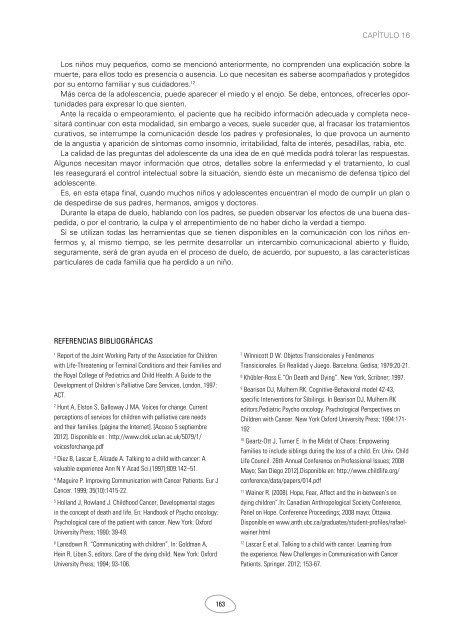Soporte_Pediatrico_para_el_paciente_Oncologico_Febrero_2013
Soporte_Pediatrico_para_el_paciente_Oncologico_Febrero_2013
Soporte_Pediatrico_para_el_paciente_Oncologico_Febrero_2013
Create successful ePaper yourself
Turn your PDF publications into a flip-book with our unique Google optimized e-Paper software.
Capítulo 16<br />
Los niños muy pequeños, como se mencionó anteriormente, no comprenden una explicación sobre la<br />
muerte, <strong>para</strong> <strong>el</strong>los todo es presencia o ausencia. Lo que necesitan es saberse acompañados y protegidos<br />
por su entorno familiar y sus cuidadores. 12<br />
Más cerca de la adolescencia, puede aparecer <strong>el</strong> miedo y <strong>el</strong> enojo. Se debe, entonces, ofrecerles oportunidades<br />
<strong>para</strong> expresar lo que sienten.<br />
Ante la recaída o empeoramiento, <strong>el</strong> <strong>paciente</strong> que ha recibido información adecuada y completa necesitará<br />
continuar con esta modalidad, sin embargo a veces, su<strong>el</strong>e suceder que, al fracasar los tratamientos<br />
curativos, se interrumpe la comunicación desde los padres y profesionales, lo que provoca un aumento<br />
de la angustia y aparición de síntomas como insomnio, irritabilidad, falta de interés, pesadillas, rabia, etc.<br />
La calidad de las preguntas d<strong>el</strong> adolescente da una idea de en qué medida podrá tolerar las respuestas.<br />
Algunos necesitan mayor información que otros, detalles sobre la enfermedad y <strong>el</strong> tratamiento, lo cual<br />
les reasegurará <strong>el</strong> control int<strong>el</strong>ectual sobre la situación, siendo éste un mecanismo de defensa típico d<strong>el</strong><br />
adolescente.<br />
Es, en esta etapa final, cuando muchos niños y adolescentes encuentran <strong>el</strong> modo de cumplir un plan o<br />
de despedirse de sus padres, hermanos, amigos y doctores.<br />
Durante la etapa de du<strong>el</strong>o, hablando con los padres, se pueden observar los efectos de una buena despedida,<br />
o por <strong>el</strong> contrario, la culpa y <strong>el</strong> arrepentimiento de no haber dicho la verdad a tiempo.<br />
Si se utilizan todas las herramientas que se tienen disponibles en la comunicación con los niños enfermos<br />
y, al mismo tiempo, se les permite desarrollar un intercambio comunicacional abierto y fluido,<br />
seguramente, será de gran ayuda en <strong>el</strong> proceso de du<strong>el</strong>o, de acuerdo, por supuesto, a las características<br />
particulares de cada familia que ha perdido a un niño.<br />
REFERENCIAS BIBLIOGRÁFICAS<br />
1<br />
Report of the Joint Working Party of the Association for Children<br />
with Life-Threatening or Terminal Conditions and their Families and<br />
the Royal College of Pediatrics and Child Health. A Guide to the<br />
Dev<strong>el</strong>opment of Children´s Palliative Care Services, London, 1997:<br />
ACT.<br />
2<br />
Hunt A, Elston S, Galloway J MA. Voices for change. Current<br />
perceptions of services for children with palliative care needs<br />
and their families. [página the Internet]. [Acceso 5 septiembre<br />
2012]. Disponible en : http://www.clok.uclan.ac.uk/5079/1/<br />
voicesforchange.pdf<br />
3<br />
Diez B, Lascar E, Alizade A. Talking to a child with cancer: A<br />
valuable experience Ann N Y Acad Sci.(1997);809:142–51.<br />
4<br />
Maguire P. Improving Communication with Cancer Patients. Eur J<br />
Cancer. 1999; 35(10):1415-22.<br />
5<br />
Holland J, Rowland J. Childhood Cancer, Dev<strong>el</strong>opmental stages<br />
in the concept of death and life. En: Handbook of Psycho oncology:<br />
Psychological care of the patient with cancer. New York: Oxford<br />
University Press; 1990: 39-49.<br />
6<br />
Lansdown R. “Communicating with children”. In: Goldman A,<br />
Hein R, Liben S, editors. Care of the dying child. New York: Oxford<br />
University Press; 1994; 93-106.<br />
7<br />
Winnicott D W. Objetos Transicionales y Fenómenos<br />
Transicionales. En Realidad y Juego. Barc<strong>el</strong>ona. Gedisa; 1979:20-21.<br />
8<br />
Khübler-Ross E.”On Death and Dying”. New York, Scribner; 1997.<br />
9<br />
Bearison DJ, Mulhern RK. Cognitive-Behavioral mod<strong>el</strong> 42-43,<br />
specific Interventions for Sibilings. In Bearison DJ, Mulhern RK<br />
editors.Pediatric Psycho oncology. Psychological Perspectives on<br />
Children with Cancer. New York Oxford University Press; 1994:171-<br />
192<br />
10<br />
Geartz-Ott J, Turner E. In the Midst of Chaos: Empowering<br />
Families to include siblings during the loss of a child. En: Univ. Child<br />
Life Council. 26th Annual Conference on Professional Issues; 2008<br />
Mayo; San Diego 2012].Disponible en: http://www.childlife.org/<br />
conference/data/papers/014.pdf<br />
11<br />
Wainer R. (2008). Hope, Fear, Affect and the in-between’s on<br />
dying children”.In: Canadian Anthropological Society Conference,<br />
Pan<strong>el</strong> on Hope. Conference Proceedings; 2008 mayo; Ottawa.<br />
Disponible en www.anth.ubc.ca/graduates/student-profiles/rafa<strong>el</strong>wainer.html<br />
12<br />
Lascar E et al. Talking to a child with cancer. Learning from<br />
the experience. New Challenges in Communication with Cancer<br />
Patients. Springer. 2012; 153-67.<br />
163



![monografia+Acaros[1]](https://img.yumpu.com/32388786/1/190x135/monografia-acaros1.jpg?quality=85)